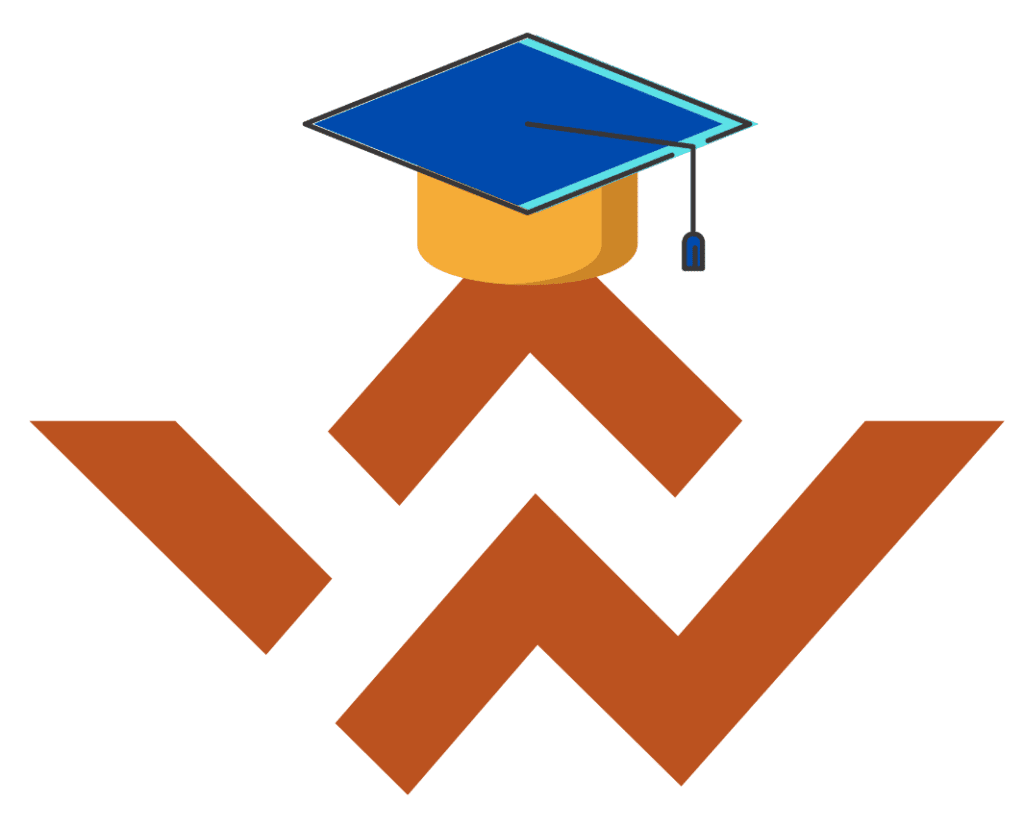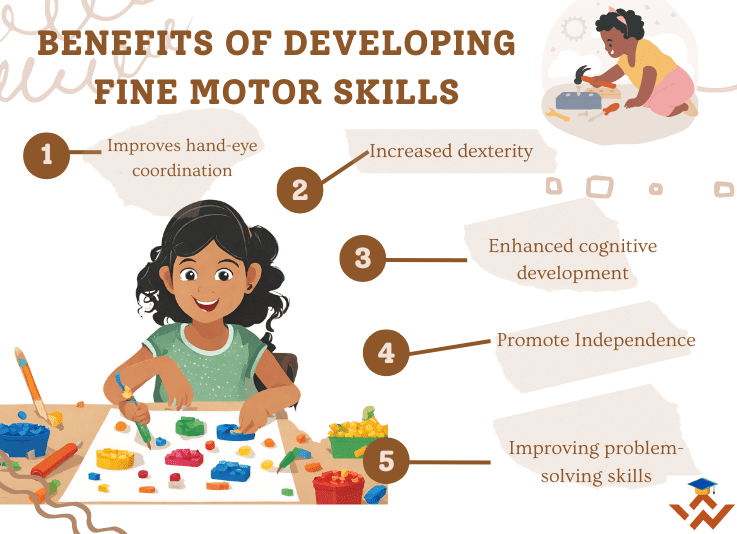Fine motor activities are the small, precise movements that are essential for many everyday tasks, such as writing, eating, and dressing. They are also important for cognitive development, as they help children develop hand-eye coordination, problem-solving skills, and self-regulation.
“The Effects of Montessori Education on Fine Motor Skills” (2015) by S. M. Rogers and L. M. Blair. This study found that children who attended a Montessori preschool program had significantly better fine motor skills than children who attended a traditional preschool program.
Another study “Montessori Education and Academic Achievement: A Meta-Analysis” (2012) by M. L. Graue and C. K. DiPerna states that Montessori children were more likely to be successful in kindergarten, as measured by their academic achievement and social-emotional skills.
Montessori education places a strong emphasis on fine motor skills. Fine motor skills provide children with an opportunity to engage their senses and learn through play, making them an excellent addition to any home or classroom setting.
In this article, we will explore activities that you can try at home or in the classroom to help the child develop their fine motor skills. These activities are not only fun and engaging, but they also have a wide range of benefits for children, including developing independence, creativity, problem-solving skills, social skills, and more. So, let’s get started and discover the power of precision through Montessori fine motor activities.
Must Read: Unlocking the Senses: A Journey into Montessori Sensorial Activities
What are Fine Motor Skills?
Fine motor skills are the ability to make movements using the small muscles in our hands and wrists. They involve actions like grasping, holding, pressing, or using a pencil, and are essential for performing everyday tasks. Developing these skills is crucial for children as it lays the foundation for a range of activities, from writing and drawing to buttoning clothes and feeding themselves.
These movements are so instinctive that we often overlook them. However, fine motor skills are much more complex. It requires coordination between the brain and muscles. They develop upon the foundation of gross motor skills. For example, for skipping a rope, one should hold the rope with both hands and rotate the rope.
Example of fine motor skills
- Gripping a pen or pencil
- Creating drawings and writing legibly
- Operating a keyboard
- Utilizing scissors, rulers, and various other tools
- Additionally, fine motor skills are essential for everyday activities like dressing oneself and brushing teeth.
What are the Benefits of Developing Fine Motor Skills?
There are many benefits of fine motor skills, but here is a list of 5 major ones:
- Improved hand-eye coordination: Fine motor skills require the use of both the hands and the eyes. When children practice fine motor activities, they are strengthening the connections between their hands and their eyes. This improved hand-eye coordination helps children with tasks such as catching a ball, tying their shoes, and writing their names.
- Increased dexterity: Dexterity is the ability to use the hands and fingers with skill and ease. Fine motor activities help children develop their dexterity, which is important for tasks such as buttoning their shirts, zipping up their jackets, and using scissors.
- Enhanced cognitive development: Fine motor skills are closely linked to cognitive development. When children practice fine motor activities, they are also strengthening the parts of their brains that are responsible for thinking, planning, and problem-solving. This can lead to improved performance in school and in other areas of life.
- Promotes Independence: Montessori education allows children to choose the activity they want to work on it independently without any adult guidance or supervision. By engaging in these activities, they develop the skills they need to become more self-sufficient and confident in their abilities.
- Improving problem-solving skills: Fine motor activities in the Montessori method can enhance problem-solving skills by providing challenges that stimulate critical and creative thinking. Activities, such as knobless cylinders or how to untie a shoelace or other such activities, help create patterns and require spatial reasoning, experimentation, and learning through trial and error. By engaging in such activities, children can improve their problem-solving skills and develop confidence and perseverance in tackling challenges.
List of Fine Motor Skills Activities for Preschoolers or Toddlers
Here are some activities for preschoolers that you can try at home or in the classroom to help them develop their fine motor skills and improve dexterity.
- Pegboard Activities: Pegboards are a classic Montessori fine motor activity. Pegboard activities involve inserting pegs into a board with holes. Children can use different colors and shapes of pegs to create patterns or designs. This activity helps develop hand-eye coordination, fine motor skills, problem-solving skills, and creativity.
- Bead Stringing/ Threading: This classic Montessori activity involves stringing beads onto a string or a pipe cleaner. This activity helps develop hand-eye coordination, dexterity, and fine motor skills. You can use a variety of beads, such as wooden beads, plastic beads, alphabet beads, pasta, and straws, for this activity.
- Lacing cards: Lacing cards are a great way for children to practice their fine motor skills. They come in a variety of shapes and sizes, and they can be used to create a variety of patterns. It involves threading a string or a shoelace through holes or eyelets. Lacing cards help children develop their hand-eye coordination, dexterity, and fine motor skills.
- Transferring Activities: These activities involve moving objects from one container to another, using tongs, tweezers, or a spoon. Examples include transferring beans from one bowl to another, transferring water using a dropper, or transferring objects using a pair of chopsticks. These activities help children develop hand-eye coordination and patience.
- Scissor Cutting: It is an excellent activity to cut paper, cardboard, or cloth with scissors. Children can begin by cutting simple shapes, like circles and squares. As they become better at cutting, they can progress to more challenging shapes, such as stars and hearts. Scissor-cutting improves hand-eye coordination, dexterity, and fine motor skills in children.
- Buttoning Activities: Buttoning activities involve buttoning and unbuttoning clothes, such as a shirt or a jacket. Dressing frames are one such example. This activity helps children develop finger dexterity and hand-eye coordination.
- Pouring Activities: Pouring activities involve pouring water or another liquid from one container to another. Examples include pouring liquid from one glass to another, pitcher to glass, and watering plants. This activity helps develop hand-eye coordination and also helps children learn about volume and measurement.
- Sorting Activities: Sorting activities involve sorting objects according to different criteria, such as color, shape, or size. This activity helps develop hand-eye coordination and also helps children learn about patterns and classification.
- Tracing Activities: Montessori Tracing activities involve tracing shapes or lines using metal insets, a pencil, or a crayon. This activity helps develop hand-eye coordination and also helps children learn about shapes and spatial awareness.
- Opening and Closing Containers: Opening and closing containers, such as jars and boxes, is an excellent activity for developing hand strength and dexterity. Children can use different types of containers, such as screw-top jars, hinged boxes, and snap-lid containers, to practice these skills. This activity can help children become more independent in opening and closing containers on their own.
Also Check: How do Montessori Students Do in High School?
List of Fine Motor Skills Activities for Kindergarteners or Primary Level
Here are some Montessori fine motor activities that are perfect for kindergarten-aged children.
- Screw and unscrew nuts and bolts: Screwing and unscrewing nuts and bolts involves using a tool, such as a wrench or pliers, to turn the bolt clockwise or counterclockwise to either tighten or loosen it. Thus, involving finger movements to develop fine motor skills.
- Sewing Activities: Sewing is a great activity for developing fine motor skills, hand-eye coordination, and creativity. Children can learn to sew simple stitches using a needle and thread. They can also create their own designs and patterns. This activity can help improve children’s concentration, patience, and attention to detail.
- Stringing Beads: Stringing beads is a great activity for developing hand-eye coordination and fine motor skills. Children can use different types of beads, such as wooden beads, plastic beads, or glass beads, to make colorful patterns. This activity can also improve children’s color recognition, pattern-making, and hand-eye coordination.
- Cutting and Pasting: Cutting and pasting activities can help develop fine motor skills as children learn to use scissors and glue. Children can cut out different shapes and then glue them onto a piece of paper to create a collage. This activity can help improve children’s hand strength and dexterity, as well as their creativity.
- Scrubbing: Scrubbing is a great way for children to develop their fine motor skills and learn about cause and effect. You can give your child a sponge and a bowl of water and let them scrub the floor, the table, or even their own hands.
- Threading: Threading activities involve threading objects, such as beads or buttons, onto a string or a shoelace. This activity helps develop hand-eye coordination and fine motor skills. Children can also improve their concentration and patience while doing this activity.
- Drawing and Coloring: Drawing and coloring activities can help develop hand-eye coordination and finger strength. Children can use different types of pencils, crayons, and markers to create their artwork. This activity can also enhance children’s creativity and imagination.
- Tracing: Tracing activities involve tracing shapes or lines using a pencil or a crayon. This activity helps develop hand-eye coordination and also helps children learn about shapes and spatial awareness. Children can also improve their hand strength and dexterity while doing this activity.
- Woodworking: Woodworking is a great way for children to develop their fine motor skills and learn about tools. You can start by giving your child simple woodworking projects, such as making a birdhouse or a toy car.
- Pin-pushing: Pin-pushing activities involve pushing pins into a pincushion or a foam board. Children can use different colors and shapes of pins to create patterns or designs. This activity helps develop hand-eye coordination, fine motor skills, problem-solving skills, and creativity.
How to Develop Fine Motor Skills in Children?
To develop fine motor skills in children, parents and caregivers can engage them in activities that are both fun and educational. It’s important to start with simple tasks and gradually move to more complex ones as the child’s abilities improve. Here are some strategies:
- Play with Playdough: Squeezing, rolling, and shaping playdough strengthens hand muscles and enhances dexterity.
- Coloring and Drawing: Encourage your child to draw or color. Holding crayons or markers correctly helps in developing grip and control.
- Puzzles and Building Blocks: These activities improve hand-eye coordination and teach children how to manipulate objects.
- Crafts Involving Cutting and Gluing: Using safety scissors and glue sticks helps children practice precision and control.
- Bead Threading and Lacing Cards: Threading beads onto a string or lacing cards are great for developing hand-eye coordination and fine motor control.
- Gardening Activities: Small tasks like picking leaves or planting seeds are excellent for enhancing fine motor skills.
What Steps should Parents Take for Promoting Fine Motor Skills in Children?
For promoting these activities, parents should:
- Provide a Variety of Materials: Offer different textures and sizes of objects to manipulate.
- Create a Regular Schedule: Incorporate fine motor skills activities into the daily routine.
- Encourage Independence: Allow children to try tasks on their own, offering help only when necessary.
- Make It Fun: Turn activities into games to keep children engaged and interested.
- Monitor Progress: Pay attention to their skill development and adjust activities accordingly.
- Seek Professional Advice if Needed: If you notice any developmental delays, consult a pediatrician or occupational therapist.
Montessori fine motor activities are an excellent way to help children develop a wide range of skills. These activities provide children with an opportunity to engage their senses and learn through play. By incorporating these activities into your child’s daily routine, you can help them develop the fine motor skills they need to succeed in a range of activities and also help them develop other skills that will benefit them throughout their lives. So, get started today and have fun with Montessori activities!
FAQs on Fine Motor Skills
- What are the big 6 fine motor skills?
Generally, fine motor skills are introduced in Big 6 + 6 sequence, encompassing actions like reaching, touching, pointing, placing, grasping, releasing, pushing, pulling, shaking, squeezing, tapping, and twisting.
- What is fine motor age 4?
Fine motor skills at age 4 typically include activities like drawing basic shapes, using scissors with supervision, threading beads, building with blocks, and dressing with minimal assistance.
- Why is fine motor skills?
Fine motor skills are crucial for tasks requiring dexterity and precision, such as writing, drawing, and manipulating objects. They facilitate independence and enable individuals to engage effectively in daily activities.



